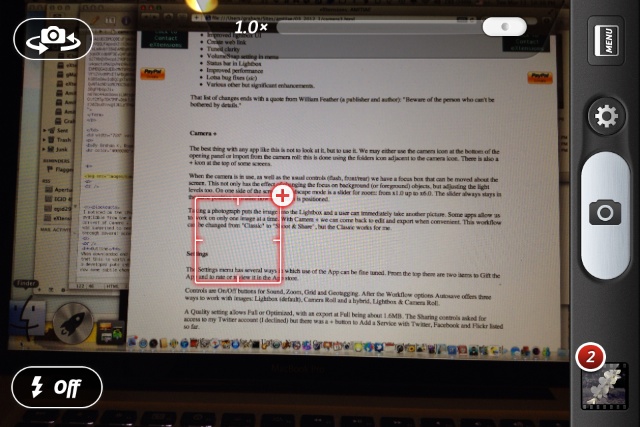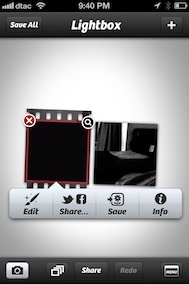Camera + Update to Version 3: A Flexible App with Some really Useful Features

AMITIAE - Tuesday 13 March 2012
|
Camera + Update to Version 3: A Flexible App with Some really Useful Features |
 |
|
|
By Graham K. Rogers
OutlineWhen downloaded and updated the first thing is the app icon. I always think that this is worth examining as this is sometimes an indication of the care that a developer puts into the app. It was already nicely designed, but there are now some subtle changes. Not needed, of course, but the developer cares.The list of improvements can be seen on the iTunes App Store page for Camera +. As it was an update, the price did not show up for me, but the developer site shows this as $0.99 which is ridiculously inexpensive for what this app does.
Improved in the update to version 3 are:
That list of changes ends with a quote from William Feather (a publisher and author): "Beware of the person who can't be bothered by details."
Camera +The best thing with any app like this is not to look at it, but to use it. We may either start with the camera icon at the bottom of the opening panel or import from the camera roll: this is done using the folders icon adjacent to the camera icon. There is also a + icon at the top of some screens.When the camera is in use, as well as the usual controls (flash, front/rear) we have a focus box that can be moved about the screen. This not only has the effect of changing the focus on background (or foreground) objects, but adjusting the light levels too. On one side of the screen in landscape mode is a slider for zoom: from x1.0 up to x6.0. The slider always stays in the same position no matter how the screen is positioned. Taking a photograph puts the image into the Lightbox and a user can immediately take another picture. Some apps allow us to work on only one image at a time. With Camera + we can come back to edit and export when convenient. This workflow can be changed from "Classic" to "Shoot & Share", but the Classic works for me.

SettingsThe Settings menu has several ways in which use of the App can be fine tuned. From the top there are two items to Gift the App and to rate or review it in the App store.Controls are On/Off buttons for Sound, Zoom, Grid and Geotagging. After the Workflow options, Autosave offers three ways to work with images: Lightbox (default), Camera Roll and a hybrid, Lightbox & Camera Roll. A Quality setting allows Full or Optimized, with an export at Full being about 1.6MB. The Sharing controls asked for access to my Twitter account (I declined) but there was a + button to Add a Service with Twitter, Facebook and Flickr listed so far. A Notifications panel for App Updates, News and Contests had all selections Off by default. Finally there was an Info panel listing the developer team and a link to Restore Purchases which required my App Store password to make the check.
Lightbox Images captured or imported from the Photo albums are available in the Lightbox. As a new and valuable feature, it is possible to import several images at once from the Photo Albums on the iPhone, either by tapping on a number of images, or using Select All. Below the image strip are 4 controls: Edit, Share, Save and Info.
Images captured or imported from the Photo albums are available in the Lightbox. As a new and valuable feature, it is possible to import several images at once from the Photo Albums on the iPhone, either by tapping on a number of images, or using Select All. Below the image strip are 4 controls: Edit, Share, Save and Info.
Share provides 4 options: email, message, create a web link and Social (facebook, Twitter, Flickr). It was the web link option that was the most interesting as a user may send the image to a Camera + page and it can be shared. As a note, although the page indicates that the photo was taken with Camera + the one I used was from my Nikon D70 and was in the camera roll. I had imported it into the Lightbox as a test. Save puts the image directly into the camera roll and it is removed from the Lightbox. An Undo button at the bottom of the screen will bring it back for further editing, while a version is kept in the albums. Info displays a lot of useful information including some basic metadata. Any effects or other editing tools used are listed in the main panel and at the bottom is a map for those images that are geotagged. Some that had been taken with my Nikon cameras did not have this so the map panel was blank, while those I took with the iPhone showed the location in a small Google maps display: nice that.
EditingPressing Edit in Lightbox brings up a panel with a fairly good selection of tools and filters in two sections below the image. The bottom line is for selection of the specific effect, while the top line gives us a range of adjustments.The first, Scenery, changes the way the light works within the image and works like white balance. There are 16 effects here, plus None, including Concert, Scenery, Text, flash and backlit. Applying these can make a significant difference to the images.
The selection of filters available using the FX Effects tool is large. These are in 3 sections (plus None), each of which has 9 options, displayed as thumbnails on a screen: Color, Retro and Special. There is also a fourth, "I "heart" Analog" section that has a shopping trolley shown. These are lovely, and I especially like the Silver Gelatin which reminded me of the "Silver" filter in CameraBag ($1.99). That pack of 9 effects was priced at $0.99 and the "Demo" sticker that had been on the image was gone as soon as I downloaded the pack. Each of these effects has an Intensity option that when accessed reveals a slider. The default was 100% when I tried, but can be reduced down to zero, to give a more subtle effect. The final effect that can be applied is to the Borders. Two sections are available here (Simple and Styled), each with nine options displayed as thumbnails.
CommentsThe work that has gone into this app is laudable. Not only are there a host of ways in which to import, edit and export the images, but the developers have provided several ways that a user may work with the app. Especially of value are the new Lightbox and the Workflow options, while the ability to import multiple images (including from Photo Stream) give the app far greater flexibility. With the use of the Lightbox to store images, the app can be used as an alternative to the iPhone camera, cutting out one step.The ease of use is a major plus point here. I was able to adjust several images, save, export and share quite quickly. Unlike some other apps, there was almost no learning time involved, the features are all so obvious. The app is apparently on offer currently at that cheap $0.99 which is a no-brainer for anyone remotely interested in using the camera with the iPhone.
Graham K. Rogers teaches at the Faculty of Engineering, Mahidol University in Thailand. He wrote in the Bangkok Post, Database supplement on IT subjects. For the last seven years of Database he wrote a column on Apple and Macs. |
|

For further information, e-mail to

|

|